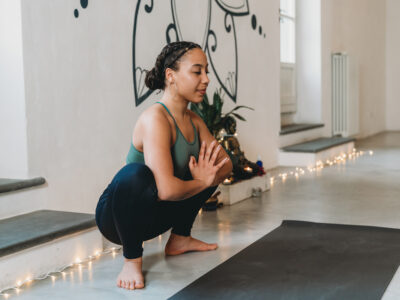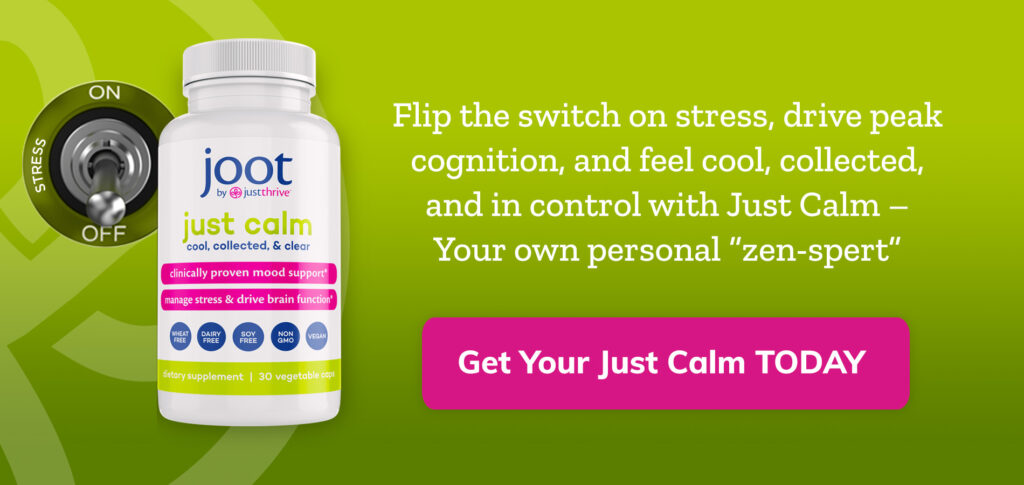Table of Contents[Hide][Show]
The fitness industry is constantly pushing us to do more, achieve more, and work more.
But what if movement wasn’t about reaching goals, but about feeling good?
Mindful movement is your invitation to slow down, breathe, and reconnect with yourself. Because wellness isn’t about steps, reps, or calories—it’s about nurturing your mind and body.
As the darkness of winter encourages reflection and introspection, mindful movement is just what you need to release stress and stay grounded in the present moment. Let’s explore this profoundly holistic practice and how you can start experiencing its benefits for yourself.
What Is Mindful Movement?
Mindful movement is the practice of being fully present while you move your body. While exercise focuses on mostly physical results—calories, gains, speed—mindful movement is all about the experience of moving your body.
How does your body feel? What information is it giving you? What thoughts or emotions are coming up? How is your breath flowing? The emphasis here is on noticing each movement and tuning into your senses—paying attention with curiosity and kindness, free from judgment.
In a goal-driven society, this might feel odd at first.
If you’re an avid walker, for example, you may be used to checking your Health app for speed, steps, distance, and other signs of progress. But with mindful movement, that same walk becomes a way of honoring your mind-body connection. Instead of focusing on your pace, you can focus on what your body is telling you. Rather than pushing yourself to the point of discomfort, it allows you to tune into your body’s signals and respect them.
But mindful movement doesn’t have to be as physical as going for a walk. Simply taking a break to stretch at your desk or dancing around your living room to your favorite song can also be forms of mindful movement. The key is to immerse yourself in your movements, physically and emotionally. Listen to what your body and mind are telling you.
In the end, mindful movement is a beautiful, holistic way to care for yourself—body, mind, and spirit. Because when you move with clear intention and heightened awareness, the benefits are incredible. Let’s take a closer look at what those benefits are.
Related
8 Morning Stretches For Car Commuters
Your morning commute can really put a strain on your body over time. Keep reading for a list of some good morning stretches to loosen tight muscles, increase blood flow, and help you deal with the stress of your day.
The Benefits of Mindful Movement
The benefits of mindful movement are profound, with positive impacts on your overall health and well-being.
Let’s explore what mindful movement can do for you.
Physical Benefits of Mindful Movement
With colder days and longer nights, it’s tempting to stay warm and cozy at home. But that could mean limiting your physical activity, especially if you’re used to hitting the gym or exercising outdoors.
Mindful movement allows you to continue moving your body but in different ways. Instead of strenuous workouts, for example, you can take time to stretch your muscles or practice yoga.
Depending on the exact form of mindful movement you choose, these gentler physical motions can:
- Release muscle tension
- Increase flexibility
- Improve your posture and balance
- Enhance your lung capacity, through intentional breathing
- Sleep better and longer
Emotional Benefits of Mindful Movement
But the benefits aren’t only physical. By integrating mindfulness into your movements, you can also create a deeper, more compassionate connection with your body.
The mind-body connection lends itself to numerous benefits for your mental and emotional health, including:
- Reduced stress and anxiety
- Lower risk of depression
- Increased self-acceptance
- Improved mood
- Better focus
- Higher resilience
.
Types of Mindful Movement
Clearly, mindful movement is a holistic approach to physical activity.
Here are some ways you can practice mindful movement and enjoy its many benefits.
Yoga
For many people, the first thing that comes to mind with the term “mindful movement” is yoga. And in fact, mindfulness is one of the core principles of most yoga practices.
This ancient Eastern practice comes in many different forms. Depending on the type of yoga you choose, the emphasis might be more on movement, physical posture, or awareness.
Here are some of the most popular types of yoga.
- Vinyasa Yoga: One of the most common yoga practices, it features flowing movements designed to build strength and flexibility.
- Hatha Yoga: Ideal for beginners, this is a slower practice that focuses on sustained postures and intentional breathing.
- Bikram Yoga: This type of yoga is practiced in a hot room, promoting detoxification and increasing flexibility.
- Yin Yoga: This gentle practice is based on deep, passive stretches held for a longer time.
- Restorative Yoga: With restful, relaxing poses, this form of yoga aims at releasing emotional and physical tension.
There are also many forms of fusion yoga, which incorporate more strenuous physical movements. These include Yoga Kickboxing, Yoga-Lates (a blend of yoga and Pilates), and Acro Yoga.
Related
Yoga for Digestion and Gut Health
Learn how to practice yoga for digestion with 5 simple yet effective yoga poses that have the greatest impact on your gut health.
Tai Chi
Although it has been gaining popularity in the Western world, Tai Chi is an ancient form of movement, rooted in Chinese martial arts and Chinese philosophy. More importantly, in this case, Tai Chi is a profound form of mindful movement, that integrates motion, breath, and awareness into one incredible experience.
Tai Chi consists of a series of slow, flowing motions that promote harmony and balance. Its very name says so! “Chi” is based on the concept of Qi, pronounced “chee.” This is your life source, the energy that flows through your body. And through the mindful movements of Tai Chi, you can unblock your Qi and find the balance between your physical and mental worlds.
The movements used for Tai Chi can be complex, coming in choreographed sequences—like yoga. As you go through your Tai Chi exercises, it’s important to remember that the emphasis is not on speed, strength, or even perfect movements. It’s about listening to your body, going at the pace that feels right, and allowing yourself to fully experience each motion.
QiGong
Qigong (pronounced “chee-gong”) is another form of mindful movement that began in ancient China. And like Tai Chi, it also focuses on your Qi, breathing, and intentional motions. This gentle practice combines soft motions, intentional breathing, and heightened awareness, making it a holistic way to nurture your overall well-being.
Sound like Tai Chi? These two practices are similar enough in movement that they are often confused. However, there are some important differences to keep in mind.
For one thing, Tai Chi still retains some of its martial arts roots, with movements that are rooted in self-defense. Qigong, on the other hand, focuses on the energy flow and directing the Qi to the proper parts of your body. Also, the movements practiced in Qigong are simpler. Instead of long, choreographed flows, Qigong uses shorter, more repetitive moves that are easier to learn and more adaptable.
Dancing
Picture it: you’re at your house or with your friends. One of your favorite songs is playing; you can feel its energy flowing through you. You let your body move in whatever ways come naturally. You’re relaxed and in the moment, enjoying nothing more than the music and the movements.
In many ways, dance is the epitome of mindful movement, freeing your mind as you free your body. But to truly make this mindful movement, leave the choreographed moves for social media or group fitness classes. Instead, let your body find its own rhythm and flow in whatever way moves you most naturally.
Mindful Walks
Is there anything simpler than a walk? With no equipment and no goal, it is one of the easiest forms of mindful movement, one you can practice almost every day.
As you walk, focus on each movement. Pay attention to how your arms swing, the sensation of your feet hitting the ground, and the rhythm of your breath. Tune into the physical experience of walking and move with intention. Notice your body’s signals and any emotions or thoughts they may bring to the surface.
Related
Stop! Now Walk – Two Minutes Is All It Takes for Greater Health
If you work in a sedentary office environment, you might go four to five hours at a time without standing and stretching your legs. We’ve covered how dangerous this can be, but what are the steps to combat the detrimental effects if a standing desk isn’t an option? A new study at the University of …
Stretching
Although the types of mindful movement we’ve looked at before now have been more physical in nature, here is one that is intentionally gentle: stretching.
When you stretch with awareness and focus, you’re engaging both your body and your mind. Take it slow. Don’t rush through your stretches merely for the sake of getting them done. Instead, slowly stretch your muscles, allowing the tension to drain from them. Take slow, deep breaths
Give yourself space to take in all of the sensations, from your muscles, your breathing, and your thoughts.
How does the stretch feel? Is there a part of your body that feels tense and might need extra attention? Sink deeper into your stretch as you exhale. Is there a stretch that feels too tight and calls for a gentler touch? Honor where your body is right now, without judgment, instead of focusing on flexibility or other goals.
Getting Started with Mindful Movement
The practices above are, by nature of their motions and philosophies, an excellent way to practice mindful movement.
But there are no limits. Almost any type of movement can be mindful. It’s all about your mindset. Take your focus off of goals and results, and place it firmly on sensations and experiences.
Practicing mindful movement is both surprisingly easy and incredibly challenging. It’s easy in that all you have to do is pick the physical activity that most appeals to your body and your mind. The challenge lies in remembering to focus on the experience, remove all judgment, and truly tune into your movements, thoughts, and emotions.
Here are some things that can help you practice mindful movement.
- Choose: Decide which form of mindful movement you’d like to try, and just do it. You can always try another one next time, until you find the one that feels right to you.
- Unplug: Turn off notifications and allow yourself to be free of digital distractions.
- Breathe: Focus on your breath. Let it flow rhythmically, aligned with the pace of your movements.
- Notice: Pay attention to your motions, how your body feels, and the thoughts or emotions your movements bring up.
- Accept: Leave judgments aside. Honor your body and your mind by gracefully accepting where they are right here, right now.
Final Thoughts
Mindful movement is a gentle yet powerful way to connect with yourself. More importantly, it’s a reminder that physical activity isn’t just about fitness; it’s about feeling wonderful—inside and out.
Stay present, focus on the process, and allow yourself to glow, physically and emotionally.
You May Also Like…







